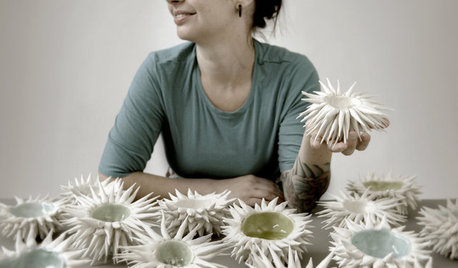how/when to till clay
farm_boy
10 years ago
Related Stories

GARDENING GUIDESGardening Solutions for Heavy Clay Soils
What’s a gardener to do with soil that’s easily compacted and has poor drainage? Find out here
Full Story
GARDENING GUIDESHow to Stop Worrying and Start Loving Clay Soil
Clay has many more benefits than you might imagine
Full Story
TASTEMAKERSInterview: Heather Knight of Element Clay Studio
Nature, architecture and a creative community inspire an Asheville artist
Full Story
GARDENING GUIDES9 Clay-Busting Native Flowers for Summer Sun
These plants survive and even thrive in tough clay soil east of the Rocky Mountains
Full Story
ROOFSRoof Materials: Get an Old-World Look With Clay Roof Tiles
The ancient roof material of choice remains the modern-day ideal for authentic Italian, Mediterranean and Spanish home styles
Full Story
COLORCooking With Color: When to Use Blue in the Kitchen
Keep your cool. We show you when to nosh around navy or try a taste of turquoise so you can stay relaxed while finishing your kitchen
Full Story
HOME OFFICESWhen Your Dining Table Is a Workspace
If you mix spreadsheets or homework with sandwiches and home fries, these tips are for you
Full Story
HOUZZ TOURSMy Houzz: 'When We Buy It, It's Forever'
This family is picky about what fills their vintage-chic Netherlands apartment, and the strategy works beautifully
Full Story
HOUSEKEEPINGAnother Independence Day: When Kids Can Do Their Laundry
Set yourself free and give your child a valuable life skill at the same time
Full Story
CONTAINER GARDENSContainer Garden Basics: How and When to Water Potted Plants
Confused about soil moisture, the best time to water and what watering device to use? This guide can help
Full Story







paleogardener
wayne_5 zone 6a Central Indiana
Related Professionals
Marina Landscape Architects & Landscape Designers · Frisco Landscape Contractors · Centereach Landscape Contractors · Danvers Landscape Contractors · Doctor Phillips Landscape Contractors · Garland Landscape Contractors · Hoffman Estates Landscape Contractors · Mastic Beach Landscape Contractors · McLean Landscape Contractors · Metairie Landscape Contractors · North Potomac Landscape Contractors · Secaucus Landscape Contractors · Boone Decks, Patios & Outdoor Enclosures · Fredericksburg Decks, Patios & Outdoor Enclosures · Santa Monica Decks, Patios & Outdoor Enclosuresluckygal
paleogardener
Kimmsr
wayne_5 zone 6a Central Indiana
Kimmsr
wayne_5 zone 6a Central Indiana
toxcrusadr
seysonn
hortster
wayne_5 zone 6a Central Indiana
klem1